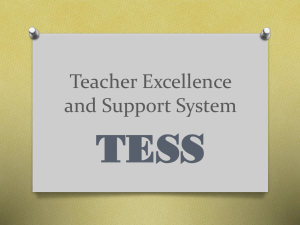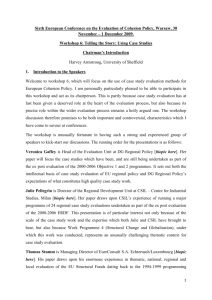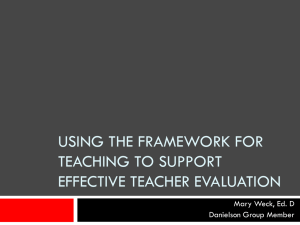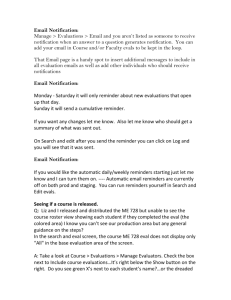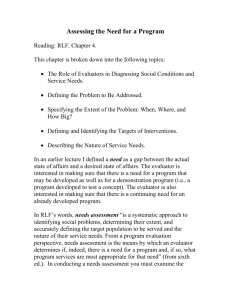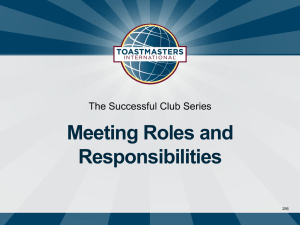Beginning an evaluation with RUFDATA
advertisement
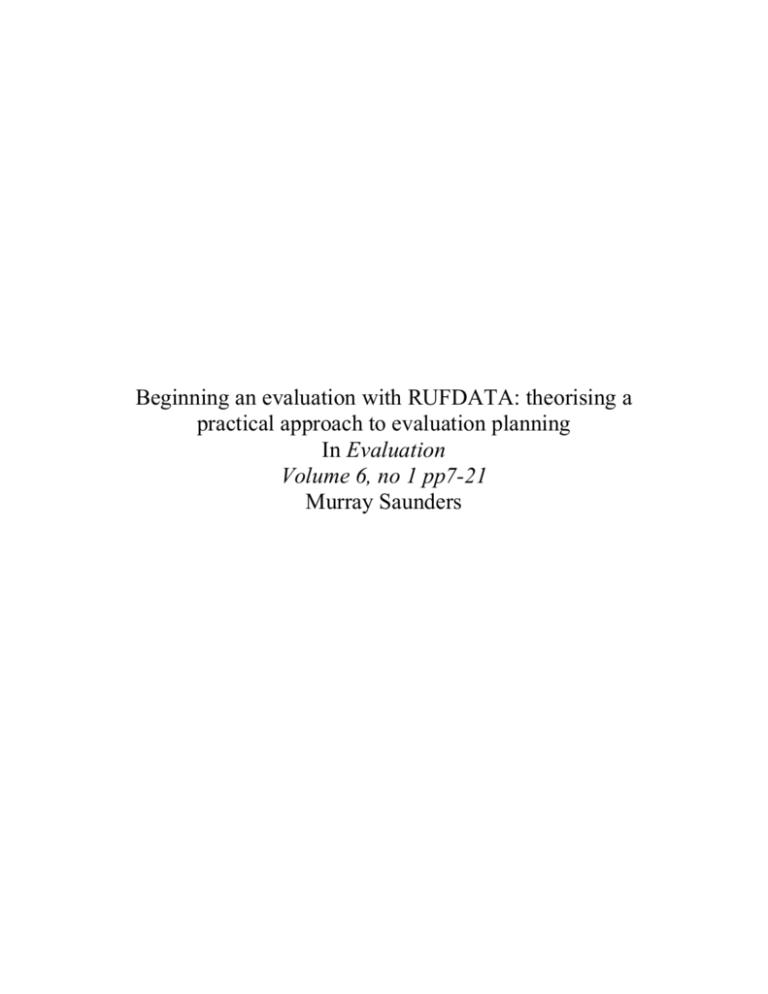
Beginning an evaluation with RUFDATA: theorising a practical approach to evaluation planning In Evaluation Volume 6, no 1 pp7-21 Murray Saunders Beginning an evaluation with RUFDATA: theorising a practical approach to evaluation planning In Evaluation Volume 6, no 1 pp7-21 Murray Saunders Introduction This paper is derived from two sources. The first source is a framework used with colleagues in CSET [Centre for the Study of Education and Training] at the University of Lancaster, UK to undertake commissioned evaluations. The framework has been used but unacknowledged and this paper renders it’s shape explicitly for the first time. The second source is from ongoing research and development work with the British Council which aims to chart evaluation practices currently undertaken by members of staff and to develop evaluation capability. The two sources are closely linked in my own practice. They combine to prompt an examination of evaluation as a collection of ‘communities of practice’ based on knowledge resources into which new evaluators might be inducted. The paper discusses this process of induction using a hybrid vocabulary from sociology, organisational theory and social psychology and introduces RUFDATA as an example of a ‘practical planning’ tool. The first source has grown more or less organically from work in CSET to support and develop individuals and groups in their 'evaluation capability'. To some extent, it is in the tradition of developing 'self evaluation' amongst practitioners, managers and policy makers. It also has connections with the tradition of Utilization Focussed Evaluation promoted and developed by Michael Patton [see Patton 1996], in that the use to which evaluation ‘products’ might be put and by whom has provided the most important steer in the decisions about it’s design. However, there is more to it than that. Patton spoke about ‘process use’ in his keynote speech to the 1997 UK Evaluation Society Conference. He was referring to the way the journey through goal clarification, discussions about audience, agency etc is a change inducing experience [see Patton 1998]. Process use, he argues, relates to and is indicated by ‘individual changes in thinking and behaving that occur among those involved in evaluation as a result of the learning and behaving that occur during the evaluation process.’[p225]. It is this learning process which is the subject of this paper. These traditions have usually involved an attempt to 'demystify' evaluation as an expert or exclusive activity and render evaluation processes accessible and do-able by any constituent group. There are dangers in taking this path. Making evaluations do-able does not mean making them easy. Evaluations are usually complex. To give simplistic short cut advice might denude and simplify a genuine body of knowledge and skill to the extent that the processes undertaken in its name are crude and unreliable. However, the attempt to promote access to and confidence in evaluative activity is laudable enough. This paper draws attention to processes involved in starting up an evaluation by those who have little or no previous experience of evaluation yet have been charged with an evaluation task. It is my belief that this happens regularly, with often less than happy results. The second resource used to develop this approach is derived from some evaluation research carried out as funded development work. This commission, for the British Council [BC] which is a quasi-independent national agency, involved a short piece of research into the current evaluation practice undertaken in BC offices worldwide. The research work which in part produced this framework was undertaken in April and May 1997 as part of the BC’s review of the planning, evaluation and reporting of aspects of its global operation. The work involved discussions on evaluation activity and approaches with a wide range of staff at its Centre in the UK along with staff from its offices in contrasting countries. This work is on-going as cases of the use of the framework is accumulated. The BC preoccupation with evaluation and its desire for a more consistent approach to it arise from the more competitive environment in which it was increasingly working. This background encouraged an awareness on the part of senior managers of the BC, of accountability, effectiveness and a need to communicate more trenchantly about the work, impact and strategic value of the BC worldwide. The brief was to develop an evaluation approach, which addressed two rather different requirements. On the one hand was increased pressure on the Centre in the UK to chart, account for and manage its world-wide operation coherently and on the other was a desire to encourage and allow local staff in each of the country offices, the capacity to develop an effective yet responsive evaluation capability. Further, there were a number of existing relevant procedures, models and activities in place. Any approach needed a design which complemented and helped to co-ordinate existing activity rather than to replace it with a new system. Using these two sources as a base, this paper suggests that it is possible to conceptualise evaluation as a series of knowledge based practices. These knowledge based practices form the resources of ‘communities of practice’ i.e. a groups of practising evaluators. In that this conceptualisation refers to any job, work or occupation, beginning to be an evaluator, just like beginning any job or work, requires the ‘novice’ to be inducted or socialised into the ‘community of practice’. Understanding evaluation activity in this way should provide the basis for some enabling ‘tools’ for thinking about an evaluation design. The learning to which Patton refers as an outcome of process use, is in fact the way we might prompt access to a reservoir of experiential and other knowledge in order for evaluations to be carried out by new evaluators, within the normative frame of a group of evaluators. In essence, it involves a process of reflexive questioning during which key procedural dimensions of an evaluation are addressed leading to an accelerated induction to key aspects of evaluation design. It enables initial planning to occur and an evaluation to ‘get off the ground’. RUFDATA is the acronym given to questions which consolidate this reflexive process. I use the phrase ‘communities of practice’ in acknowledgement of the paradigm diversity of evaluation work. In short there are many communities of practice into which a novice evaluator might enter. So, the process I have set out refers to particular novices, working with particular evaluators on specific projects. It is, in that sense, a very ‘situated’ approach and makes no assumptions about substantive content in terms of method, focus or use. To that extent, the approach is a ‘meta-evaluative’ tool. This paper draws on these two distinct sources. On the one hand an approach to evaluation which has developed as practice by a group of evaluators working together on evaluation commissions and on the other, a specific piece of research commissioned to lead to the development of an approach built on existing systems but also on tacit and unacknowledged evaluation knowledge. Practice, communities and evaluation knowledge This section will explore the intersection of some key ideas in this reconceptualisation of novice evaluator activity. I mention above the elements of this reconceptualisation. First, evaluators are understood as working in forms of community. This idea has been developed by Lave and Wenger [1991] who coin the term ‘communities of practice’. It is a variant on the notion that any social group forms recurrent behaviours which are governed by certain norms and values into which a new ‘recruit’ or ‘novice’ or ‘entrant’ would need to be socialised. More recently, Wenger [1999] has captured the essence of this process succinctly ‘Over time, this collective learning results in practices that reflect both the pursuit of our enterprises and the attendant social relations. These practices are thus the property of a kind of community created over time by the sustained pursuit of shared enterprise. It makes sense, therefore, to call these kinds of communities communities of practice’. [p45] Critical to the discussion in Wenger’s work, as in the argument of this paper, is the notion of practice. Her book explores the dimensions of practice in terms of ‘meaning production’, the ways communities work, the way practice is bound into the process of learning and knowing. She identifies what practices do but does not construct a definition of a ‘practice’ as such. In order to clarify these thoughts, I revisited my own use of the term 'work practice' in the context of evaluation and how it might be changed and developed. I also drew on the concept of a 'practice' in the early work of Anthony Giddens namely 'New Rules of Sociological Method', 'Central Problems in Social Theory' and 'The Constitution of Society'. In all these publications, Giddens uses the same basic conceptual frame of reference which underscores the way practices work in Wenger’s schema. His notion of practical refers to behaviour, which is recurrent, or routine i.e. happens on a day to day basis and is embedded in the normal routine of daily life. Therefore a 'practice' is a way of doing something; the pattern of which is reproduced in a social context [i.e. work] according to certain rules. The idea of 'routinization' is important for us because it refers to the habitual, taken for granted character of the vast bulk of the activities of day-to-day working life. Giddens uses the notion of 'ontological security'[!] to refer to the impulse we have to create and sustain 'routines' through practices in order for us to feel safe and secure in our day to day actions i.e. we can predict with a degree of certainty what is likely to happen as a result of a particular event or act. I mention above a need to make 'explicit' ways of doing something or the experiential knowledge held by a group or an individual in the work place, which is somehow locked in practice and implicit with its contribution to collective learning thus muted or constrained. A worthwhile goal therefore is to enable such implicit knowledge to become accessible, enter the public domain and initiate a 'learning spiral' through some kind of learning process. From an evaluation point of view there are two other distinctions which seemed immediately relevant to our discussion. Giddens distinguishes between two types of consciousness which have bearing on the process we have described above. He gives the designation 'discursive' to the consciousness of the conditions and meaning of a person's own actions in the work place to which they are able to give verbal expression. I take this to mean a kind of awareness someone might be able to describe. However Giddens also identifies what he calls 'practical consciousness' which is what someone might know about their work practices including the conditions of their own action, but cannot express 'discursively'. This is a problem to which Giddens has no obvious answer. Although he does say ‘Where what agents know about what they do is restricted to what they can say about it, in whatever discursive style, a very wide area of knowledgeability is simple occluded from view. The study of practical consciousness must be incorporated into research work'.[Giddens 79 p105] But, how do we make 'practical consciousness' available such that it can be rendered accessible for learning? He does say that there is nothing highly bounded in the distinction between the discursive and the practical. In the circumstances we are discussing, the unacknowledged procedures of evaluation planning can be derivedis from an exploration of practical consciousness prompted by the discussion of interpretations of events, actions or products arising from the work of some evaluator practitioners. Another set of distinctions worth building is the components of a 'work practice'. The rules which govern such practices may be derived from the organisational culture [interactional culture, division of labour, authority, power, decision making procedures, production organisation] and contingent factors [profitability, market share, etc]. They may also be derived from the logic of the technical dimension of the job itself. These components operate at three systemic levels i.e. macro, meso and micro, any combination of which may yield resources for discursive and practical consciousness and the basis of a set of knowledge resources. By definition, a practice is given shape by recurrent social relations over time, so it is plausible to look for examples of discursive and practical consciousness in evaluators because it Consists of all the things which actors [evaluators] know tacitly about how to 'go on' in the contexts of social [working] life without being able to give them direct expression.[Giddens 79 p107] In the provision of a practical framework for evaluation then, we should be focusing on aspects of the evaluator's work which consists of problem solving and procedural guidance using a community of practice of evaluators as a resource. But, in what sense might an evaluation framework be ‘practical’ i.e. based on practices? In day-to-day usage, the idea of the ‘practical’ has a cluster of meanings: solving everyday problems, having an obvious utility or relevance, emphases on the procedural rather than the theoretical and use of a straightforward and accessible kind are all immediately recognisable. ‘Practical’ conveys the idea of action rather than consideration, of doing rather than reflecting. I am not using the term quite like this although there are elements of this everyday use I want to retain. Because the idea of the practical pursued here is derived from the idea of 'practice', a practical framework is one which is built on the practices associated with an occupational or 'professional' group. It is a variant of the stance taken by Patton which is framed by an over-riding concern with establishing the potential 'use' of an evaluation which will, in turn determine many of its features. The idea of 'practical' in this paper is more closely aligned to the general domain of problem solving as part of every day work within an area of occupational practice. In this case, it is the way evaluators undertake their work on a routine basis that forms the raw material for the articulation or induction of people into evaluative practice. If Giddens is right, practical consciousness is where a lot of work based problem solving will be taking place. We should be trying to find ways of 'freeing' this resource for use by the 'learning evaluator'. However, knowledge, whether it is practical in the way I describe above, discursive or 'technical', has been described in different ways. But, before turning to a consideration of ‘knowledge’ in the context of evaluation, I want to consider further insights Wenger offers on the way we might think about practice. She argues that key elements in the process of constructing meaning for a novice are ‘participation’ and ‘reification’. Although familiar, the idea of participation is important because it signals the active involvement of a novice as a member of a social community. It is a source of ‘mutuality’, of negotiated meaning and produces an ‘identity of participation’ [Wenger 99 p56]. It suggests that learning to be [in this case an evaluator], requires participation in evaluation practice. She makes three other interesting points on ‘participation’. First, participation is not necessarily the same as collaboration and might involve quite different and unequal relationships. Second, participation both shapes our experience and involves communities being shaped by us as we engage in practice. Third, participation is broader than engagement in practices. It can provide the source of a professional identity which shapes our engagement with other communities of practice or other groups. In the context of evaluation, Wenger’s point suggests that an evaluator’s relationship with, say politicians, irrespective of the nature of a specific encounter, will shape the way the encounter proceeds. Reification is of particular interest in the context of this paper in that it refers to the way in which processes and practices are consolidated into ‘artifacts’ or things. Wenger talks about experience becoming ‘conjealed’ into ‘points of focus around which the negotiation of meaning becomes organised’[Wenger p58]. A community of practice produces ‘abstractions, tools, symbols, stories, terms and concepts that reify something of that practice in a congealed form....with the term reification I mean to cover a wide range of processes that include making, designing, representing, naming, encoding and describing...’[Wenger 99 p59] In this sense, RUFDATA is an example of reification derived from the consolidated practices of a group of evaluators providing a ‘tool’ for those in the process of induction. Interestingly, a reified procedure, like RUFDATA is based on several different types or images of knowledge. However, mapping the knowledge base of a community of practice, in the form of reified practice or other forms of knowledge, is not straightforward [see Saunders 95]. Blackler [95], for example suggests that organisational theory has characterised 5 different types or 'images' ' of knowledge generated by work practices within organisations. In terms of the professional knowledge of evaluators and the procedural culture they might generate, I have borrowed his categories and applied them to evaluation, not as organisational knowledge, but as a set of knowledge resources we might want to make explicit as we induct new evaluators. Each of these types of knowledge are resources produced through and for learning by a potential 'community of practice'. Blackler's paper identifies the following 'types' of knowledge which he suggests characterises any kind of working environment, not just those defined as 'knowledge based work places' involving 'knowledge workers'. First, he identifies 'embrainied knowledge' which might be more or less the equivalent to 'propositional' knowledge, dependent on conceptual skills and cognitive abilities of participants and which, in the evaluation domain, might refer to the body of formal theory and research associated with carrying out evaluations. Second is 'embodied knowledge', which is action oriented and likely to be only partly explicit. In essence it is the 'way we do things here'. It may encompass both technical fixes and interactional knowledge. The point is that it is not necessarily written down or formalised and individuals are socialised into rather than 'trained in' its use and acquisition. It is highly context bound and depends on an intimate experiential knowledge of ways of doing things. We might liken it to the informal 'house style' of a specific evaluation agency. RUFDATA is an example of a reified embodied practice. Which, once made explicit might become part of the third type of knowledge in Blackler’s framework. This is 'embedded knowledge' which resides in systemic or even emergent routines, relationships between technologies, roles and formal procedures. This knowledge is explicit and is generated by the interconnected requirements of parts of a complex system. In evaluation, embedded knowledge refers to knowledge of explicit evaluation systems and procedures which discipline activity in as much as they might specify procedures or items of information. In looking at the interconnection between these frameworks, it seems important to understand reification as forms of embedded knowledge on a continuum of formality or, to use Wenger’s language, the extent to which practices have been ‘congealed’ into procedures. The knowledge implied in a good quality system, for example, we can describe as embodied knowledge, congealed into embedded knowledge. Fourth is 'encultured knowledge' which refers to the process of achieving shared understandings. Linked to the process of socialisation and acculturation, this type of knowledge is language based, socially constructed and negotiable. It refers to the 'discourse' of a community of work based practice. In evaluation terms it is the discourse of a particular set of evaluation practices. This discourse might include, for example, terms like 'commission', 'stakeholder', 'impact', 'use', 'resource', 'audience', 'worth' and 'value' etc. It is interesting to note, in the light of the observations made above about evaluation being several communities rather than a unified community of practice, the extent to which the vocabulary and the discourse of evaluation has any shared core. To compare the discourse or encultured knowledge of a naturalistic evaluation with audit on the one hand or a controlled trial on the other, suggests great limitations. Fifth, is 'encoded knowledge’, which is information conveyed by signs and symbols, traditional forms [hard copy] and emergent forms [electronically]. The fifth type concerns more knowledge transmission, storage and interrogation than a distinctive type of substantive knowledge. However, where the way evaluators encode knowledge becomes important is in the sensitivity they might have to the way participants or stakeholders engage with the products of an evaluation. The form in which evaluation outcomes are communicated is of central importance and the underdevelopment of encoded knowledge can be a critical factor in an evaluation’s failure. A less differentiated set of categories are those presented by Michael Eraut [1993, 1994] in which he identifies three broad types of 'professional learning'. First, he cites underpinning knowledge and understanding of concepts, theories, facts and procedures. He collapses Blackler's categories and does not distinguish between the explicit and the tacit levels at which professional knowledge of this kind works. Second, he identifies the personal skills and qualities' required for a professional approach to the conduct of one's work. In evaluation this might include the ethical standards to which we aspire. It is however, difficult to identify with any real clarity just what is professional about the occupational qualities to which Eraut refers. Finally he refers to the cognitive process which constitute professional thinking which are usually tacit and relatively inaccessible to the 'learner' and might be both 'technical' and 'attitudinal'. What is intriguing about these examples is the relationship between types of knowledge, and, for our purposes, the extent to which they might be captured and represented and under what cultural conditions. I have argued that evaluations involve communities of practice which produce and use different types of knowledge into which a novice evaluator is inducted. But, not everyone called upon to undertake an evaluation has the opportunity to be systematically inducted into a community of practice. In fact most are not. In the light of these realities, types of how to handbooks develop. Patton’s book on utilization focussed evaluation [1996] is a particularly good case in point. It is replete with reified practice in the form of menus providing starting points for novice evaluators. These menus, however, embody knowledge of many different types. It can be helpful to disentangle these types in order to be more explicit about the kind of evaluation knowledge, reified into ‘ways of doing things’, we discuss with new entrants into communities of practice. If discussion opportunities are minimal, then it seems to me that the approach most likely to be accommodated by non-evaluators is non elaborate, would not be over specified or require high levels of fidelity but be a robust framework at a sufficient level of generality to allow for high levels of local adaptability and expression. The development of RUFDATA To complicate things further, we need to acknowledge the circumstances under which novice evaluators’ work. In most cases, evaluation is not the central core of their working practice. It is usually the case that they are called upon or think it useful to undertake evaluations from time to time. In most cases they are managers, administrators, teachers etc i.e. individuals working with a wide variety of professional preoccupations. As such, they will have the 'practicality ethic' of people working in organisational settings. Following Giddens, we need to take account of the way people at work operate within sets of routinised practices. It is these practices which will determine the way in which people spend their working day, prioritise activities and decide on what is worth spending time and what is not. These practices and the norms, which govern them, constitute a complicated set of personal and organisational incentives and disincentives. Most importantly, an evaluation framework will be used or not used depending on how it 'fits' with these incentives as well as how it fits with the community of practice of evaluators. In the organisational setting for which RUFDATA was originally conceived, the 'evaluation' requirements to which people had been accustomed were best described as a series of monitoring and planning mechanisms administered by the Centre for overall operational control and consistency. This was a strict discipline and heavily prescribed, numerical and relatively superficial. Staff working in the dispersed offices of the BC expressed their 'practicality ethic' in the context of this experience. Their evidence from interview suggests some operating characteristics for an evaluation. Below are the words they used to describe the principles they might sign up to. Designed for users Terse and clipped style Bullet pointed Checklists Supporting explanation or notes Non elaborate Adaptable to local circumstances Malleable Flexible Pulling in the same direction Working for us Involving everyone Helping us all know where we are going In considering these points, the approach they advocated should be robust enough to provide a framework that all dispersed offices could use and fulfil the various purposes they outlined. Approaches which are high in 'fidelity', are not appropriate for complex, dispersed organisations. In other words, an approach, which depends heavily on the precise specification and performance of its various components in order for it to work at local level will be subverted, understood as a necessary evil or even resented as a tool of surveillance and control. What is required is an approach low in fidelity. The metaphor of a 'framework' is apt. A framework should provide a generic context for action in which some recognisable shaping characteristics are evident but within the shape, a wide range of actions is possible. This interpretation of the context suggested a framework, which would enable each office to fulfil some basic evaluation activity and a reporting mechanism for its activities within a coherent management process. It should however, be based on the practices of an evaluation community and serve a practicality ethic. It is evident to me that while RUFDATA was conceived with a particular context in mind, it’s characteristic as embodied evaluation knowledge offers wider potential use. The next section of this paper focuses on the specific context of RUFDATA within the work with the British Council but should serve to illustrate more general use. Using RUFDATA RUFDATA is an acronym for the procedural decisions, which would shape evaluation activity in a dispersed office. They stand for the following elements. Reasons and purposes Uses Focus Data and evidence Audience Timing Agency RUFDATA provides the basis for a series of decisions, which can frame evaluation activity at two levels in an office. Level one concerns the development of a policy statement or position paper on the approach the office wishes to adopt on evaluation overall. Level two, concerns the evaluation of a specific activity. The point is that these decisions evoke the tacit decision making which a group of experienced evaluators undertook in planning and thinking about an evaluation, in other words it accesses their embodied knowledge of considerations useful in starting up an evaluation. However, the process does not stop there because once this practice is captured and represented in more systematic form, it becomes reified as a kind of procedure and thus emerges as embedded knowledge in Blackler's terminology. These self-directed decisions are shown in Table form below. Table 1 Evaluation Decisions Using RUFDATA What are our Reasons and Purposes for evaluation? These could be planning, managing, learning, developing, accountability What will be our Uses of our evaluation? They might be providing and learning from embodiments of good practice, staff development, strategic planning, PR, provision of data for management control What will be the Foci for our evaluations? These include the range of activities, aspects, emphasis to be evaluated, they should connect to the priority areas for evaluation What will be our Data and Evidence for our evaluations? numerical, qualitative, observational, case accounts Who will be the Audience for our evaluations? Community of practice, commissioners, yourselves What will be the Timing for our evaluations? When should evaluation take place, coincidence with decision-making cycles, life cycle of projects Who should be the Agency conducting the evaluations? Yourselves, external evaluators, combination Mini Case Study of RUFDATA use: Developing an evaluation policy for an office I note above that a level one use of RUFDATA is the production of an office policy statement. This mini case details the use of RUFDATA to develop such a statement. Generally the statement is best generated by a team of individuals including the staff and managers of the office to maximise 'ownership' and meaning for all potential users and to maximise ‘process use’ in Patton’s terms. It provides an opportunity to confirm broad goals and clarify tasks and targets. The idea was that the statement should reflect the priorities and circumstances of the work of the staff in a specific office and is considered as 'our' policy. Context The Deputy Director[DD] of this medium sized office was keen to develop an evaluation approach for all the projects undertaken and for specific evaluations of library use, and all teaching activities. The Director, while happy to see this development and supportive in a general sense, was not too sure what evaluation had to offer and had a sceptical view. The DD on the other hand had attended a seminar held by the UK Evaluation Society while in the UK and was convinced that an evaluation approach adopted by all staff could have a range of benefits beyond measurement of objectives and management control. The DD was also very keen that as many staff as possible signed up to the approach so they would have a strong sense of ownership and involvement. Process The DD decided to take the staff through a three stage process using RUFDATA as a basis. This case study will report on stage 1. Stage 1 Undertake a RUFDATA activity with all the staff [10] to establish an approach for the whole office. Stage 2 Agree with the staff that they pilot evaluation with at least one aspect of their work over a 6-month period, again using RUFDATA as a basis. Stage 3 Have a staff development day during which staff could a] report back on the outcomes of their evaluation b] report back on the process of using a common approach to evaluation, in particular the balance between the input of resources and the gains. Stage 1 The RUFDATA exercise for all staff was undertaken during a two-hour staff development slot. The Director was asked to attend because the DD considered it important to send the right signals of support to the rest of the staff. The 12 participating staff were divided up into three groups of 4 and asked to go through RUFDATA for one hour. The second hour was used to synthesise the work of the three groups. The DD acted as a facilitator for this session and found that the groups had a core of agreement under all the headings. To help the groups work, the DD had briefed the Director and one other member of staff in advance of the meeting. With the agreement of the staff, the DD was asked to produce a document based on the synthesis from all the groups which could then be circulated and refined by all members of staff. The DD was responsible for collating all the comments and the final document was agreed two weeks after the first meeting. The RUFDATA document is summarised in Fig.2. For stage 2, the staff were given a 6 month period in which to initiate a small-scale evaluation to pilot the approach. Most staff had some experience in designing evaluation instruments like questionnaires but were not confident. They felt they needed some extra support, if only from each other, to produce a wider range of instruments. To help with the feedback the DD designed a framework for reporting. The DD also encouraged staff to meet and talk about the evaluation and form self help groups. At stage 3 there was a range of quality in the reporting of the staff’s evaluations but all had completed at least one evaluation and had used RUFDATA. Most complained about the time to undertake evaluation but could see the benefits, particularly process use. I have included below notes of the content of the RUFDATA process in Figure 2 Figure 2 Synthesised RUFDATA for Office Evaluation Policy What are our Reasons and Purposes for evaluation? Staff wanted to stress the developmental use of evaluation and the way it might help to manage a project by forming a planning framework at the project idea stage. The managers were keen to use evaluation for giving feedback to the Centre and for writing Country Reports. They particularly stressed finding good news. To provide feedback to the Centre To provide a resource for Country Reports To use as a planning framework To get feedback from stakeholders and participants on the experience of an event or project What will be the Uses of our evaluation? Evaluation reports will be incorporated into Country Reports Evaluation reports will be used with new partners to design projects Evaluation reports will be used as a resource for monthly reviews Evaluation reports will be used as de-briefing resources at the end of projects Presentational material/PR What will be the Foci for our evaluations? Each separate project will have an awareness assessment [local media] Each separate project will evaluate experience of key stakeholders [participants, partners, project managers] Each separate project will identify ‘success criteria’ which will form the basis of a judgement on value and worth [includes changed behaviour or views] What will be our Data and Evidence for our evaluations? For awareness, mainly media penetration, mentions etc., head counts of attendees For experience, mainly questionnaire with sample interviews where possible For impact, follow up interviews Occasional in depth cases with observations alongside questionnaires and interviews It was decided to design standard core instruments for all the main areas of activity Who will be the Audience for our evaluations? Mainly ourselves with a secondary audience of external interests [central senior managers] but we would write external reports using the original evaluations as resources. Partners who need to know how well/badly the event their funding helped to support went Local media Other BC offices What will be the Timing for our evaluations? To coincide with country reports For each project life cycle In a planned rolling programme Who should be the Agency conducting the evaluations? Mainly self evaluation [i.e. undertaken by the project team, managers of areas of activities] Occasionally for bigger projects or where clear independence is required, by an external evaluator. The Statement was developed into a short document which considered evaluation under the RUFDATA headings and which could be reviewed on an annual basis although it might have some continuity over time. My suggestion was that it formed the basis of the evaluation culture of a specific office. The Director or someone with an evaluation brief [evaluation manager] might have a facilitative role but the collective ownership and production of this document was an important element in the development of an evaluation culture. Feedback from the process of planning in this way from office staff indicated that the language of RUFDATA was straightforward and unambiguous. Staff suggested that they did not want to be distracted by puzzles over nuances of meaning e.g. differences between goals, aims, objectives, elements, components etc. RUFDATA categories could be used for both evaluation policy statements and the evaluation of a specific activity. The experience in the mini case study suggested that at the start of planning a new activity, the RUFDATA process could be undertaken and used as a planning tool. After a process in which each of the categories in RUFDATA is considered, a short working document with responses to each of the RUFDATA categories forms the evaluation framework for that activity. Conclusions This paper is presented as a contribution to the development of a 'practice' driven evaluation approach that could be used to support self-evaluations particularly in dispersed organisations. In using the data derived from the research in the BC offices it was apparent that gaps in evaluation capacity do not lie in the design of evaluation instruments but rather in thinking like an evaluator and making an initial start. In other words capacity is to do with the extent to which individuals or groups are part of a ‘community of practice’. We are dealing with cultural rather than technical matters here, at least in the first instance. It has argued that to enable evaluation activity to get off the ground, novice evaluators should be inducted into the community of practice of a group of evaluators. The practices characterising the work of evaluators [like any occupation] are shaped by the knowledge resources they produce and reference. In that it is not always possible for novice evaluators to be actively socialised into a community of practice, we may have to use reifications of embodied knowledge to help. RUFDATA is such a system. From the point of view of the Centre of a dispersed organisation like the British Council, the evolution of an evaluation culture within offices might contribute to a sharper appreciation of the overall mission. This evolution inevitably requires an inclusive approach to evaluation management and strategic planning. The approach advocated in this paper should be managed as an 'horizontal' activity with maximum involvement of members of staff on the ground. One last summary point is that a useful distinction can be drawn between different types of information demand. Dispersed offices are routinely asked to provide a considerable amount of what can be termed 'management information' for the Centre. This information does not in itself constitute a judgement of value or worth which is at the heart of evaluation. It is descriptive, usually numerical, often financial and concerned with the volume and scope of activity. It is essential for planning and resource allocation. However, to arrive at a judgement on value and worth, an insight into the quality of the experience from the point of view of the key stakeholders is required. This evidence can only be indicative never definitive. Its quality depends on the extent to which a situation, activity or event is depicted evocatively from different stakeholder's points of view. RUFDATA aims to provide an enabling framework in which this process might take place. References Blackler F [1995] Knowledge, Knowledge work and organisations: an overview and interpretation in Organisation Studies vol. 16 , no. 6 pp 1021-1045 Eraut M & Cole G [1993] Assessment of Competence in Higher Level Occupations Competence and Assessment No.22 pp I 0- 1 4 Eraut M [1994] Developing Professional Knowledge and Competence [London: The Falmer Press] Giddens A [1976] New Rules of Sociological Method [London Hutchinson] Giddens A [1979] Central Problems in Social Theory [Macmillan] Giddens A [1986] The Constitution of Society [Cambridge, Polity Press] Lave J and Wenger E [1991] Situated Learning: legitimate peripheral participation [Cambridge: Cambridge University Press] Patton M Q [1996] Utilization-Focused Evaluation [Sage] Patton M Q [1998] Discovering Process Use Evaluation Vol 4 no 2 pp 225-233 Saunders, M [1995] Researching Professional Learning Journal of Computer Assisted Learning, Vol I 1, no 3, pp 231-238 Wenger E [1999] Communities of practice, learning, meaning, and identity, [Cambridge: Cambridge University Press]
